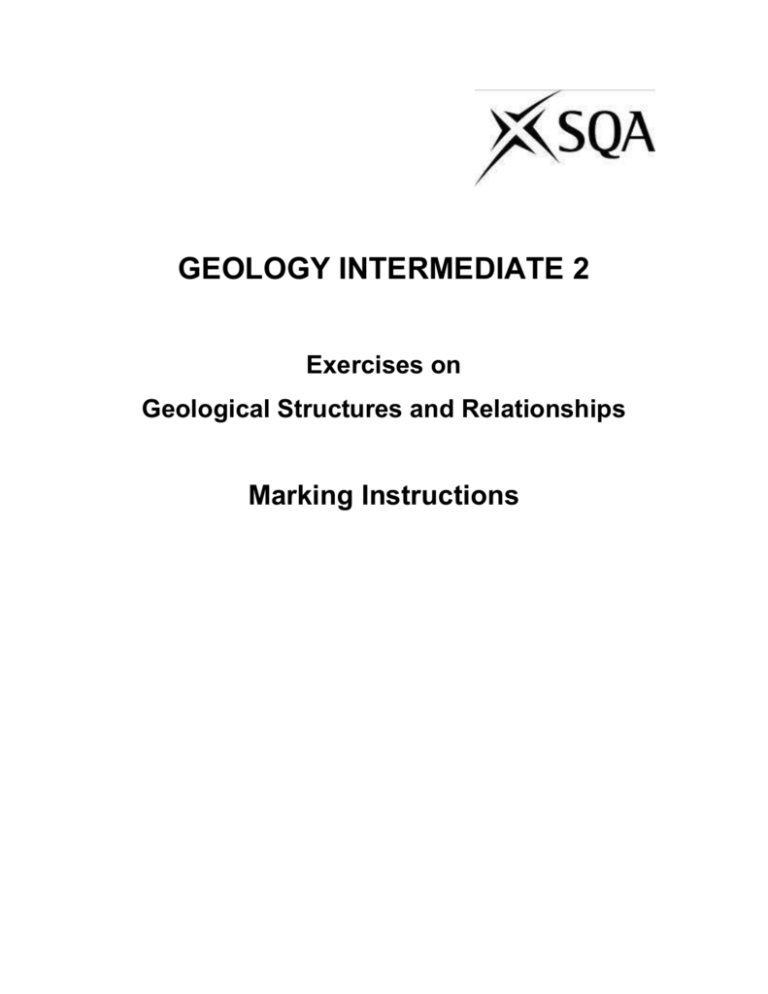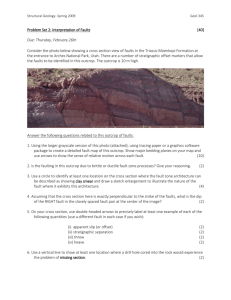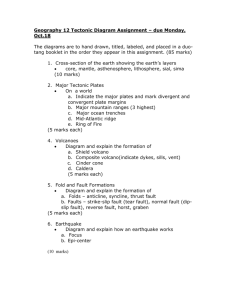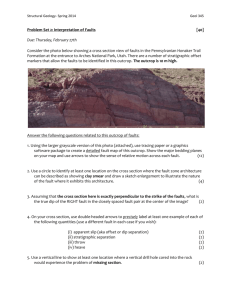Intermediate 2 Answers
advertisement

GEOLOGY INTERMEDIATE 2 Exercises on Geological Structures and Relationships Marking Instructions 1 (a) (i) Diagram 1 (a) 10m fault (ii) Younger beds on the right have been moved down so they now lie against older beds on the left. Outcrops on the left of the fault are repeated on the right of the fault. Exercises on Geological Structures and Relationships – Marking Instructions 1 1 (b) (i) Diagram 1 (b) 10m (ii) Older beds on the right have been moved up so they now lie against younger beds on the left. Beds which do not outcrop on the left of the fault now outcrop on the right of the fault. Exercises on Geological Structures and Relationships – Marking Instructions 2 1 (c) i. Question 1 (c) ii. Younger beds on the right have been moved down so they now lie against older beds on the left. The outcrop pattern is the same on both sides of the fault but the outcrops have been moved sideways along the fault. Exercises on Geological Structures and Relationships – Marking Instructions 3 1 (d) i. Question 1 (d) ii. Older beds on the right have been moved up so they now lie against younger beds on the left. The outcrop pattern is the same on both sides of the fault but the outcrops have been moved sideways along the fault. The same shift of outcrops seen in 1(c) and 1(d) would be produced by a tear fault. Thus, the outcrop pattern alone does not allow you to distinguish between a tear fault and a fault on which vertical movement has taken place. Exercises on Geological Structures and Relationships – Marking Instructions 4 1 (e) i. Diagram 1 (e) ii. Younger beds on the right have been moved down, so they now lie against older beds on the left. When an anticline is moved down the outcrop of the beds in the core of the fold becomes narrower. Exercises on Geological Structures and Relationships – Marking Instructions 5 1 (f) i. Diagram 1 (f) ii. Older beds on the right have been moved up so they now lie against younger beds on the left. When an anticline is moved up the outcrop of the beds in the core of the fold becomes wider. Exercises on Geological Structures and Relationships – Marking Instructions 6 1 (g) i. Question 1 (g) ii. Younger beds on the right have been moved down so they now lie against older beds on the left. When a syncline is moved down the outcrop of the beds in the core of the fold becomes wider. Exercises on Geological Structures and Relationships – Marking Instructions 7 1 (h) i. Diagram 1 (h) ii. Older beds on the right have been moved up so they now lie against younger beds on the left. When a syncline is moved up the outcrop of the beds in the core of the fold becomes narrower. Exercises on Geological Structures and Relationships – Marking Instructions 8 Completion Exercises for Maps 2 (a) Map 2 (a) Rocks on the right have been displaced downwards, so younger conglomerate on the right now lies adjacent to older mudstone on the left. 2 (b) Map 2 (b) Rocks on the right have been displaced upwards, so older limestone on the right now lies adjacent to younger mudstone on the left. Exercises on Geological Structures and Relationships – Marking Instructions 9 2 (c) Map 2 (c) Rocks on the right have been displaced downwards, so younger rocks on the right now lie adjacent to older rocks on the left. 2 (d) Map 2 (d) Rocks on the right have been displaced upwards, so older rocks on the right now lie adjacent to younger rocks on the left The same shift of outcrops seen in 2(c) and 2(d) would be produced by a tear fault. Thus, the outcrop pattern alone does not allow you to distinguish between a tear fault and a fault on which vertical movement has taken place. Exercises on Geological Structures and Relationships – Marking Instructions 10 2 (e) Map 2 (e) Younger beds on the right have been moved down, so they now lie adjacent to older beds on the left. When an anticline is moved down, the outcrop of the beds in the core of the fold becomes narrower. 2 (f) Map 2 (f) Older beds on the right have been moved up, so they now lie adjacent to younger beds on the left. When the anticline is moved up, the outcrop of the beds in the of the fold becomes wider. Exercises on Geological Structures and Relationships – Marking Instructions 11 2 (g) Map 2 (g) Younger beds on the right have been moved down, so they now lie adjacent to older beds on the left. When a syncline has been moved down, the outcrop of the beds in the core of the fold becomes wider. 2 (h) Map 2 (h) Older beds on the right have been moved up, so they now lie adjacent to younger beds on the left. When a syncline has been moved up, the outcrop of the beds in the core of the fold becomes narrower. Exercises on Geological Structures and Relationships – Marking Instructions 12 2 (j) Diagram 2 (j) Because there has been no vertical movement on the fault, the widths of the outcrops of the anticlines and synclines are the same on both sides of the fault. Exercises on Geological Structures and Relationships – Marking Instructions 13 2 (k) Diagram 2 (k) The rocks on the right have been displaced downwards, so younger rocks on the right now lie adjacent to older rocks on the right now lie adjacent to older rocks on the left. Because the rocks on the right have moved downwards, the outcrop of the rocks in the core of the anticline has become narrower and the outcrops of the rocks in the cores of the synclines have become wider. Exercises on Geological Structures and Relationships – Marking Instructions 14 Establishing Age Relationships 3 (a) B→F→E→A→D→C 3 (b) D→E→C→B→F→A 3 (c) D→C→B→F→A→E 3 (d) C→A→D→E→F→B 3 (e) F→B→A→C→E→D 3 (f) E→D→A→F→C→B Exercises on Geological Structures and Relationships – Marking Instructions 15 BLOCK DIAGRAMS 4 (a) i. Syncline ii. Anticline iii. Thrust fault iv. Unconformity v. Dyke P has been broken and displaced upwards on the left hand side of fault F. The upraised block has been eroded down so all traces of the dyke on the left of the fault have been removed. vi. C→B→F→A→E→D 4 (b) i. Formed by the deposition of sediment on an older erosion surface. (It represents a break in the stratigraphical succession) ii. One iii. On surface S, gneiss overlies sandstone.Gneiss is a metamorphic rock so it cannot have been deposited on top of the sandstone. The surface separating the gneiss and sandstone must be a fault plane and not an unconformity. iv. B→A→E→F→D→C 4 (c) i. Dyke ii. Sill iii. Movement on the fault has been mainly in a horizontal direction so dolerite P shows a marked displacement. In addition to a large horizontal movement there has been a slight vertical movement which has slightly moved the granite. Or Movement on the fault has been at a slight angle to the horizontal. Exercises on Geological Structures and Relationships – Marking Instructions 16 iv. 4 (d) i. ii. 4 (e) i. F→D→A→E→C→B B,C, E D→E→B→C→F→A Batholith or stock ii. Dyke iii. It is transgressive Or It moves from one level to another Or It cuts the fault so it must be intrusive iv. E→C→F→A→B→D 4 (f) i. Two ii. Five iii. It is overlain by a fossil soil. Soils from only on land. iv. C v. B→C→E→F→A→D 4 (g) i. Normal fault ii. Reverse fault iii. Dyke Exercises on Geological Structures and Relationships – Marking Instructions 17 iv. 4 (h) i. D→B→E→A→F→C Batholith or stock ii. The dolerite cuts faults FP,FQ and FR. It must be intrusive. iii. Fault FQ displaces fault FP but it does not displace the horizontal lava. Movement on fault FQ must be in a horizontal direction which means that it is a fear fault. iv. Fault FP v. Fault FR vi. C→A→F→B→D→E 4 (j) i. Anticline ii. Syncline iii. Reverse iv. Granite – dyke Dolerite – sill Gabbro – stock v. E→F→A→D→B→C 4 (k) i. Unconformity ii. Normal iii. Reverse iv. No displacement is visible. You cannot tell what type of fault it is without seeing how the rocks have been moved. v. Hornfels – red shading in mudstone close to the granite Marble – green shading in limestone close to the granite Exercises on Geological Structures and Relationships – Marking Instructions 18 Metamorphic quartzite – blue shading in sandstone left of fault FR close to gabbro vi. Falls; down; faster; flooded; rises; raised beaches vii. B→A→D→F→C→E MAPS 5 (a) i. Dyke ii. Sill iii. Unconformity iv. Tear fault v. East side vi. D→E→F→A→C→B 5 (b) i. Thrust fault ii. Ancient volcano or neck or plug (or vent) iii. Anticline iv. East. Younger limestone on the east is adjacent to older sandstone on the west. The eastern side must have been moved down. Or The outcrop of the beds in the care of the anticline is narrower on the eastern side of the fault. This narrowing takes place when beds folded into the form of an anticline are moved down. v. West. Younger limestone on the west is adjacent to older sandstone on the east. The western side must have been moved down. Or Exercises on Geological Structures and Relationships – Marking Instructions 19 The outcrop of the beds in the core of the anticline is narrower on the western side of the fault. This narrowing takes place when beds folded into the form of an anticline are moved down. vi. 5 (c) i. E→C→A→F→B→D Syncline ii. iii. Tear fault. The dolerite dyke has been displaced. Because the dyke is vertical, movement on the fault has been horizontal. Or The width of the outcrop of the synclinally folded beds is the same on both sides of the fault. This shows that there has been no vertical movement on the fault. iv. South West Younger sandstone on the South-West is adjacent to older limestone on the North-East. The South–Western side must have been moved down. Or Exercises on Geological Structures and Relationships – Marking Instructions 20 The outcrop of the beds in the core of the syncline is wider on the SouthWestern side of the fault. This widening takes place when beds folded into the form of a syncline are moved down. v. North–East Older sandstone on the North–East is adjacent to younger sandstone on the South–West. The North–Eastern side must have been moved down. Or The outcrop of the beds in the core of the syncline is wider on the NorthEast side of the fault. This widening takes place when beds folded into the form of a syncline are moved down. vi. B (the outcrop on the downthrown side of fault FR is smaller than the outcrop on the South-West side of the fault. The narrower part of the gabbro intrusion has been moved down to lie adjacent to the wider part.) vii. B→F→C→E→A→D 5 (d) i. It gives off transgressive side shoots. Lava flows do not intrude adjacent rocks. ii. Dyke iii. The fault runs along the line of the dyke (dolerite P). Tear fault (Because of the displacement shown by the outcrop of the granite.) iv. Batholith or stock v. Volcano is in North-West corner of map. vi. D→C→A→E→F→B 5 (e) i. Letter A should be written on the limestone ii. Letter S should be written in the middle of the mudstone iii. North-West side. Older limestone on the North-West side of the fault is adjacent to younger sandstone on the South-West side of the fault. Thus, the rocks on the North-West side have moved up. Exercises on Geological Structures and Relationships – Marking Instructions 21 Or On the North-West side of the fault the outcrops of the beds in the cores of the anticlines are wider than those on the South-East side. Such widening takes place when beds folded into the form of an anticline are moved up. Or On the North-west side of the fault the outcrops of the beds in the cores of the synclines are narrower than those on the South- East side. Such narrowing takes place when beds folded into the form of a syncline are moved up. iv. v. 5 (f) i. E→F→A→C→B→D Sandstone ii. Conglomerate P iii. Unconformity Exercises on Geological Structures and Relationships – Marking Instructions 22 iv. Thrust fault v. Dome vi. South-East Older limestone on the South-East side of the fault is adjacent to younger mudstone on the North-West. The older rock on the South-East has been moved up to lie at the same level as the younger rock on the North-west. Or The outcrop of the folded rocks is wider on the South –East side of the fault. Such widening occurs when rocks folded into the form of a dome are moved up. vii. Tear fault viii. C→B→F→D→A→E 5 (g) i. Dyke ii. Volcanic plug iii. The oldest rock (mudstone) is in the core of the fold. (If the fold was a syncline the youngest rock would be in the core.) iv. Tear fault The rocks on the North-West side of the fault have been moved to the South-west by about 200m. v. Normal fault Rocks in the South-East side have moved down. (Younger limestone on the South-East side is adjacent to older mudstone on the North-West side. The limestone has been moved down to be at the same level as the mudstone. Also, the rocks in the care of the anticline have a narrower outcrop on the South- East side. Such narrowing means that rocks folded into the form of an anticline have moved down.) vi. The rocks on the South-East side have been moved 400m to the SouthWest. vii. F→A→B→E→D→C Exercises on Geological Structures and Relationships – Marking Instructions 23 viii. There are no cross cutting relationships to allow you to establish relative ages. 5 (h) i. ii. 5 (j) i. A,D,E D→E→F→C→B→A 67o or 247o ii. A, C iii. Syncline iv. North–East When the rocks in the core of a syncline are moved down, the width of the outcrop increases. The outcrop of the mudstone is wider on the North-East side, so the North-East side has been thrown down. v. The intrusion which forms granite S has vertical walls, so the intrusion has a cylindrical shape. Vertical displacement will not change the crosssectional shape of the cylinder. vi. B→F→A→E→D→C 5 (k) i. Tear fault ii. Sandstone iii. Basin iv. South-east When rocks folded into the form of a dome or syncline are moved down, the width of the outcrop increases. The conglomerate has a longer or wider outcrop on the South-east side of the fault so the South-east side has been thrown down. Or Exercises on Geological Structures and Relationships – Marking Instructions 24 The conglomerate has been moved down to lie adjacent to older limestone. v. E→D→C→F→A→B SECTIONS 6 (a) i. A piece of rock picked up and carried by magma which is subsequently enclosed by igneous rock formed from the magma. ii. Schist and conglomerate iii. Reverse iv. Unconformity v. Deposited by moving ice vi. E→B→C→A→F→D 6 (b) i. It is transgressive or It changes from one level to another or It intrudes along two fault planes ii. Batholith or stock iii. Normal iv. 3 metres v. C→F→E→A→D→B 6 (c) i. Thrust fault Exercises on Geological Structures and Relationships – Marking Instructions 25 ii. Unconformity iii. Dyke iv. Sill. The same limestone is found above it and below it. To separate the limestone like this it must be intrusive. v. There are no cross cutting relationships to allow you to establish relative ages. vi. C→A→F→D→B→E 6 (d) i. Syncline ii. Anticline iii. Three iv. When lava is erupted into the sea rapid chilling causes the surface of the lava flow to solidify while the inside remains liquid. The liquid lava bursts through the solid skin in blobs which solidify as pillows. v. D→E→A→B→F→C 6 (e) i. Thermal or contact metamorphism ii. Metamorphic aureole iii. Mudstone is more easily metamorphosed than sandstone. Or The minerals in mudstone are more easily changed by heat than the minerals in sandstone. Or New minerals grow more easily in mudstone than in sandstone. Or Exercises on Geological Structures and Relationships – Marking Instructions 26 Mudstone has a wider variety of minerals than sandstone. This makes mudstone more susceptible to change when it is heated. iv. Batholith or Stock v. Sill vi. It transgresses or changes levels so it must have been intruded vii. B→D→A→F→E→C 6 (f) i. P - Thrust fault Q - Thrust fault R - Unconformity S - Unconformity ii. B iii. E→F→D→A→C→B 6 (g) i. Normal ii. It cuts through faults so it must be intrusive iii. Dyke iv. The rocks to the right of dolerite S have been displaced downwards relative to those on the left. This displacement occurred by movement on a fault before the dolerite was intruded. v. D→B→C→E→F→A Exercises on Geological Structures and Relationships – Marking Instructions 27









